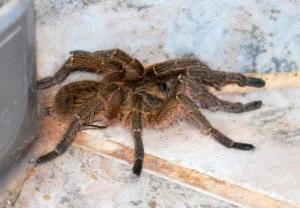I was visiting my son on the farm he managed in Pretoria. I was hanging out in the hammock between two trees, simply gazing around, while the Grandies slept. It was absolute bliss, the breeze very gentle, but keeping it from being unbearably hot. As I looked across towards the paddock, I noticed a quick movement and flash of blue on a tree trunk. So I ‘observed’. It was what we call a ‘bloukop’, which translates as ‘bluehead’!
Oh my word! I hadn’t seen one of these since I was a child in Zambia! I was fascinated, but equally terrified of them then! They lived in the trees around the boundaries of the garden. They’d scuttle around, going about their business and I adored watching them. But their quick rush from one place to the next always gave me palpitations!
These South African Agamas were a breeding pair, as I soon discovered. The male resplendant in his mating colours and the female pretty in her Sunday best. They got used to me over the next few days, as I never came too close, but only watched, chatted about them to Gaz and took photos. They stopped running and hiding, and just ignored us, posed for photos, and watched us with as much curiosity.
I was thrilled to see them again!
Information:
SWAHILI NAME FOR LIZARD: Mjusi, Mijusi (plural)
PHYSICAL CHARACTERISTICS:
The Blue-Throated Agama, Agama atricollis, is a very large agama, reaching a maximum length of 15 inches.
Its head, particularly in males, is large and triangular. The head and body are distinctly separate. The ear openings are larger than the eyes, and the tympanums (eardrums) are visible.
Agamas have strong limbs. Their bodies are compact and spiny. The scales on the body are small and keeled, with those along the back larger and mixed with scattered, enlarged, spiny scales.
Breeding males have a dull blue to bluish back, with bright blue to straw-yellow spines. The head is a coppery-green to brilliant ultramarine on top, blue-green on the sides and peacock-blue on the throat. There is a large black spot on each side above the shoulder, and a broad, blue-green to yellowish vertebral stripe. The tail is dull green to olive-brown.
Females and non-breeding males are olive to green-brown, marbled with black above, with a black shoulder spot. Juveniles have a similar ground color, with dark X-shapes surrounded by white blotches along the sides. The tail is banded with dark brown-black.
DISTRIBUTION and HABITAT:
These agamas are found in the open savanna, and along the edges of forests in Kenya and Ethiopia, extending through East Africa to Natal.
BEHAVIOR:
These beautiful lizards are frequently seen nodding their heads in display while clinging to a tree trunk. Most Agamas are terrestrial, but this species is arboreal. They come to the ground only to cross to another tree, and occasionally to eat.
When threatened, they retreat around the tree trunk, always keeping the trunk between themselves and danger. They will gape the mouth widely, showing the bright orange mouth lining, and will deliver a painful bite if caught. Contrary to popular belief, they are not poisonous.
They sleep at night in a hollow branch or under peeling bark.
DIET:
Agamas are fond of flying ants and termites, and supplement their diets with grasshoppers and beetles.
REPRODUCTION and GROWTH:
The female lays 8-14 oval, soft-shelled eggs in a hole dug in moist soil. They hatch after about 90 days. Hatchlings measure 70-80 mm (about 3 inches). They triple in size in their first year, but growth slows thereafter. They become sexually mature in their second year.





































